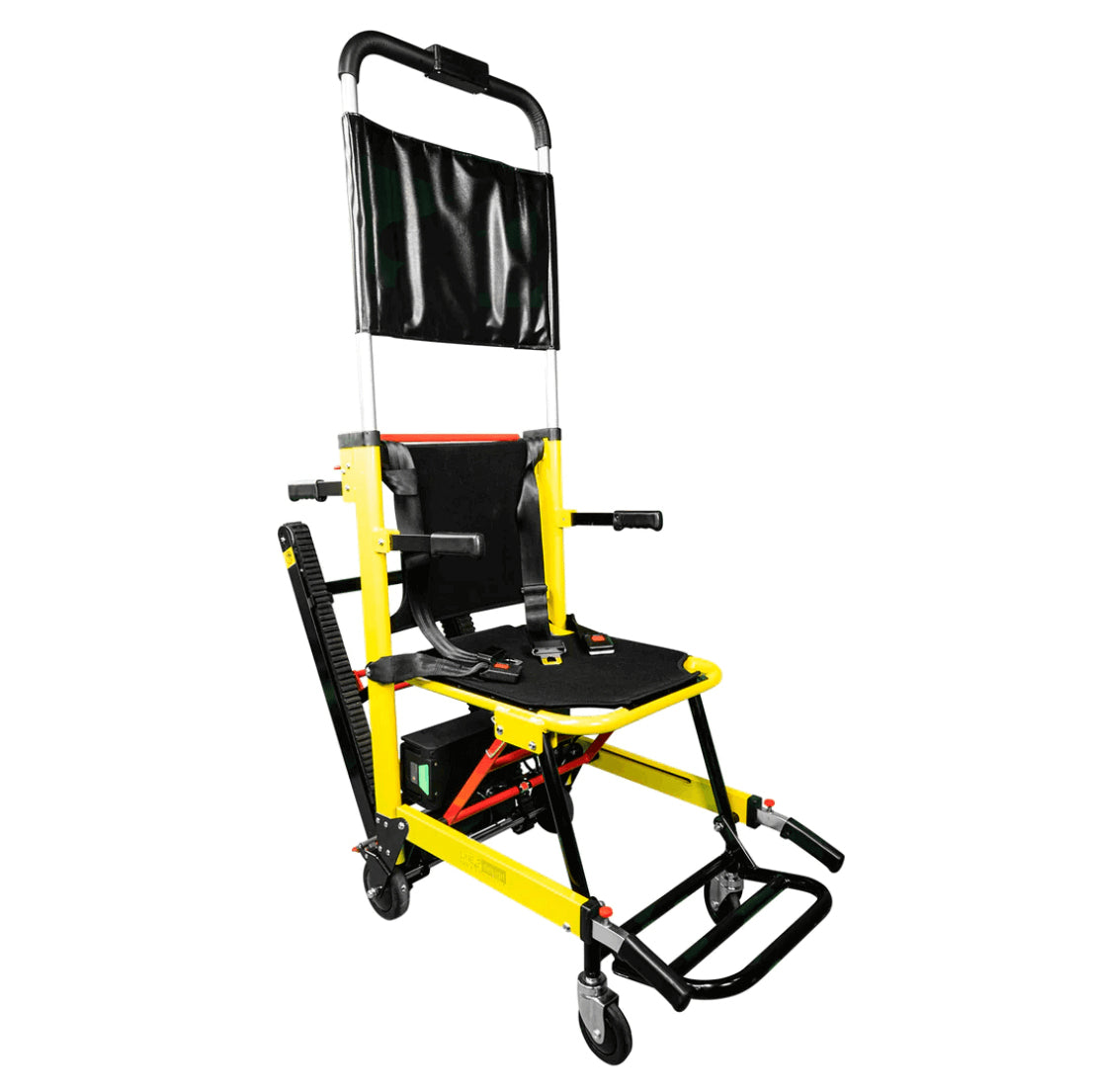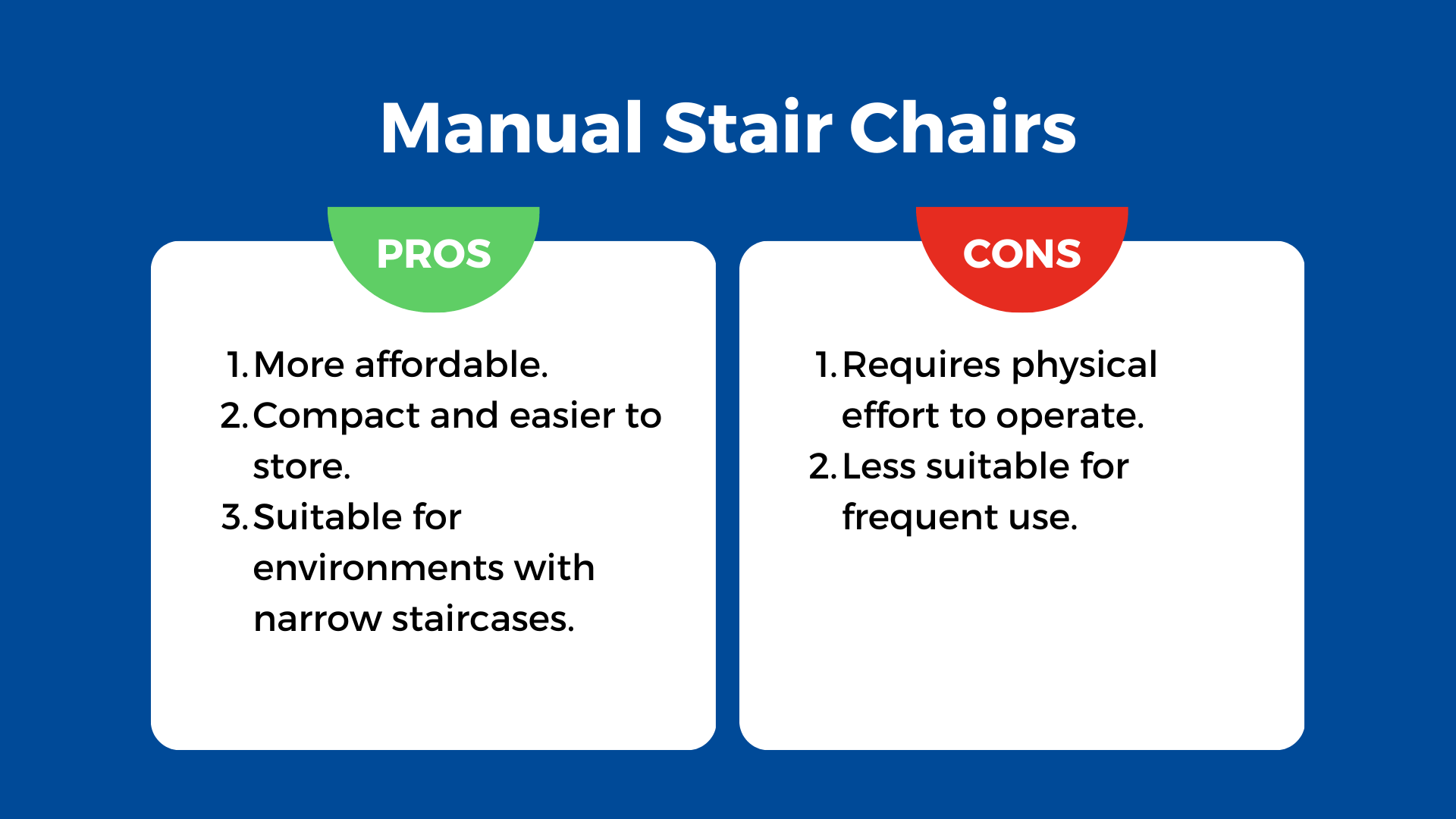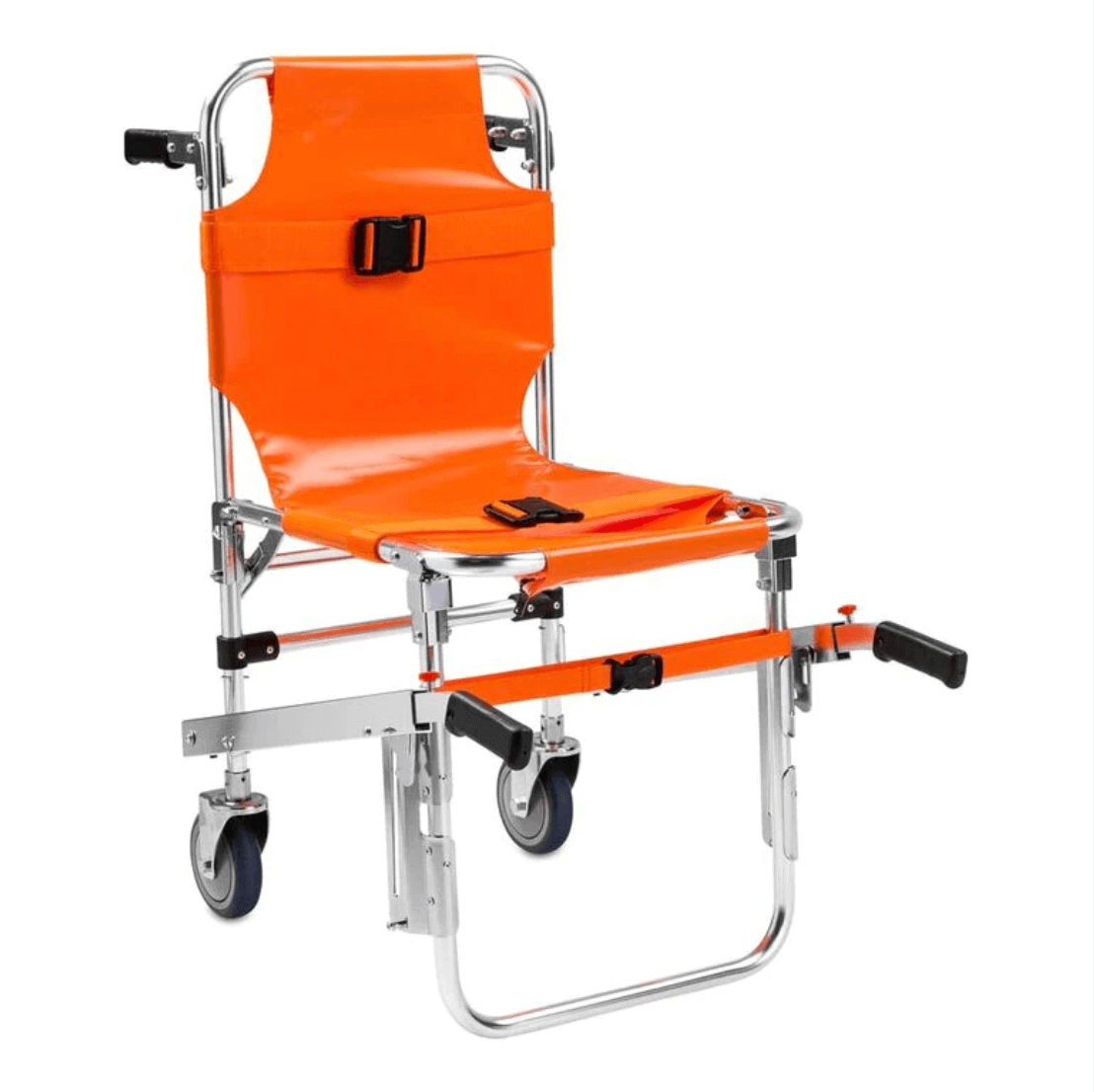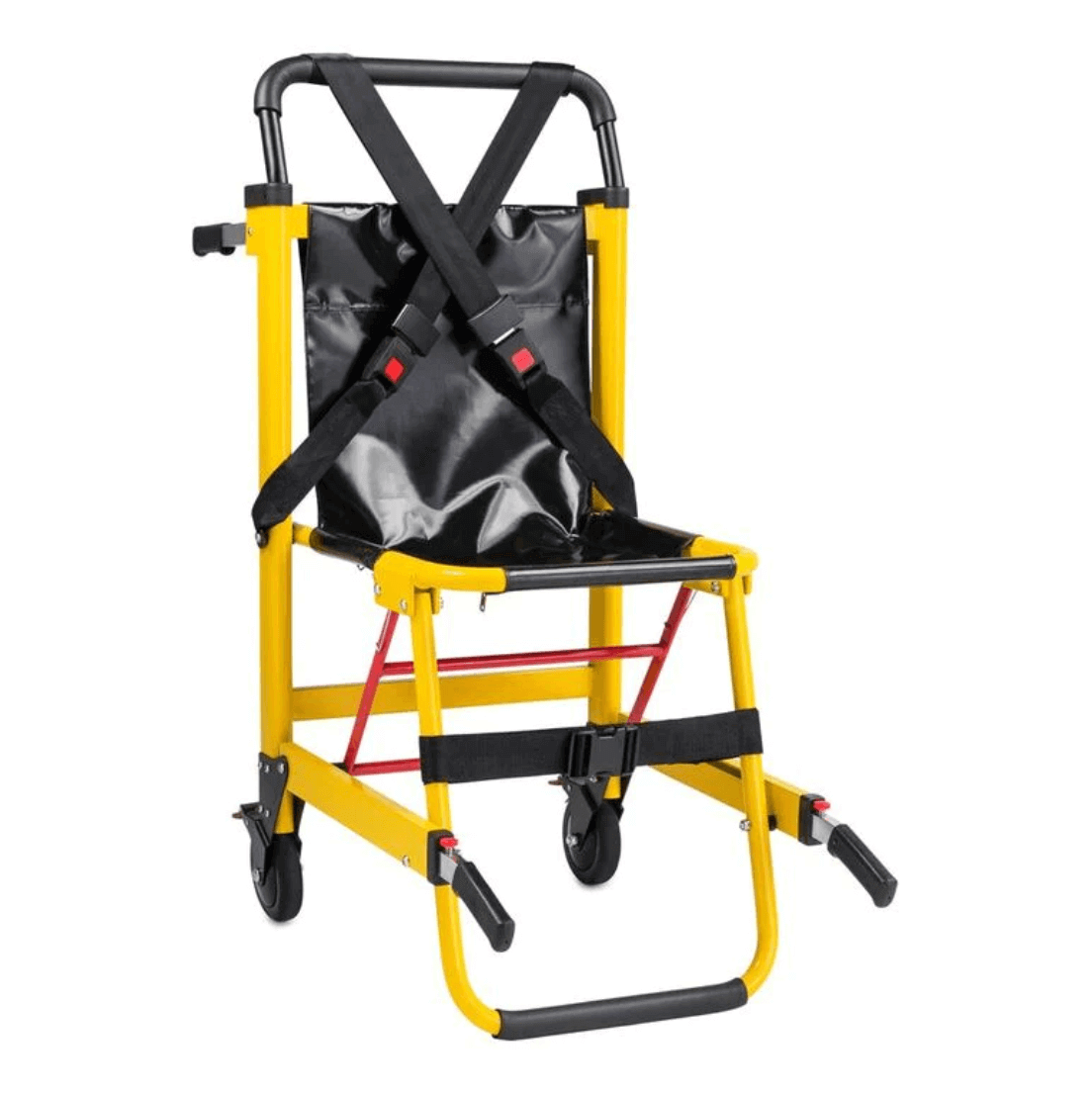A Comprehensive Guide to Selecting the Best Stair Chair

Stair chairs are indispensable in Emergency Medical Services (EMS) and in assisting individuals with mobility issues. These specialized chairs offer a safe and efficient way to navigate stairs during medical emergencies or everyday life for those with mobility impairments. This comprehensive guide will delve into the various aspects of stair chairs, from their definition and historical evolution to the types available, including motorized, manual, and compact models.
We'll also explore their vital role in EMS, examine user considerations, safety features, and the importance of comfort and ergonomics. Additionally, we will compare motorized and manual options, discuss advanced features and technologies, and offer insights into maintenance, customer reviews, and frequently asked questions. By the end of this guide, you'll have a thorough understanding of stair chairs and the knowledge to make an informed decision for your specific needs.
Who Uses Stair Chairs?
Stairlifts and chairs have a rich history, with their earliest known use dating back to King Henry VIII's era, and have evolved significantly since then. Today, they serve a wide range of individuals and professionals:
People with Permanent Disabilities
Offer autonomy to wheelchair users, enabling easier movement between floors and assisting in emergencies.
Educators and Children with Disabilities
In educational settings, stairlifts and chairs enhance accessibility for both students and teachers with mobility issues.
Those who are Temporarily Disabled
Ideal for short-term recovery from injuries, mobile stairlifts and chairs offer a practical solution for those temporarily impaired.
Loved Ones of People with Disabilities
Stairlifts and chairs aid in adjusting to life with mobility impairments, enhancing freedom and independence for both the individual and their family.
People with Balance Issues
For those using walking aids, stairlifts and chairs provide a safer option for navigating stairs, which can be challenging with crutches or frames.
Emergency Personnel
Stairlifts and chairs are invaluable for first responders during emergencies for quick evacuation of multiple individuals.
The Elderly
Stairlifts and chairs can significantly improve the independence of seniors, helping to alleviate feelings of isolation or dependence on caregivers.
Caregivers
For caregivers, finding the right stairlift or chair involves balancing the needs of the person they are caring for with their own.
Understanding Stair Chairs
Stair chair versus stair lift–what’s the difference? The primary difference between a stair lift and a stair chair lies in their design and intended use. A stair lift is a permanent fixture installed along a staircase, equipped with a seat and a rail system for transporting individuals up and down the stairs. It's designed for people who have difficulty navigating stairs but can sit and transfer independently.
On the other hand, a stair chair is a portable device, typically used in emergency or healthcare settings, to manually carry an individual up or down stairs by caregivers or EMS personnel. Unlike a stair lift, a stair chair does not require installation and offers more flexibility for varied environments.
Stair chairs are essential devices designed to transport individuals safely, particularly in environments lacking elevator access. These chairs are pivotal in EMS, allowing quick and safe evacuation from multi-level structures. They are also crucial for people with mobility impairments in homes, ensuring mobility across different floor levels.
The inception of stair chairs dates back to the early days of emergency response and patient care when the need for efficient transportation in stairway scenarios was recognized. Initially simple in design, these chairs have undergone significant evolution, incorporating advancements in materials and technology. This evolution has led to enhanced safety features, improved maneuverability, and increased comfort for both the user and the operator.
Types of Stair Chairs
- Motorized Stair Chairs: These chairs are a boon in EMS and healthcare facilities, featuring motorized mechanisms to ease the transport process, which is especially beneficial for heavy-duty use or when moving heavier patients.
- Manual Stair Chairs: More traditional in design, these chairs require physical effort to operate. They are typically lighter, offering maneuverability in narrow staircases or confined spaces.
- Compact Stair Chairs: Ideal for environments where space is at a premium, compact models offer the basic functionality of stair chairs but can be easily stored and transported, making them a practical choice for smaller residences or facilities.
Understanding the variety and capabilities of each type of stair chair is crucial in selecting the right one for specific scenarios, whether for emergency medical services or aiding mobility in residential settings.
The Importance of Stair Chairs

The history of stair chairs is fascinating, tracing back to different innovations and adaptations over time. The earliest known stair chair was developed for King Henry VIII in the 16th century, featuring a block-and-tackle system to assist his movement between floors after sustaining an injury. In the 1920s, C.C. Crispen, a Pennsylvanian entrepreneur and engineer, invented a device called the Inclin-ator, initially designed to help a friend with mobility impairments. These early inventions laid the groundwork for modern stair chairs, which have since evolved significantly in terms of design, functionality, and safety features. This evolution reflects the ongoing need to assist individuals with mobility challenges in navigating multi-level environments safely and efficiently.
The role of stair chairs is multifaceted and crucial across various settings. We'll examine the reasons for their necessity in each context, supported by relevant statistics, and discuss how stair chairs enhance safety and mobility for individuals with mobility issues or emergencies.
- EMS Stair Chairs: Stair chairs are vital in EMS for safely transporting patients in multi-level environments. They are crucial for quickly moving patients from confined spaces, a common scenario in urban EMS operations. Since many elderly falls result in emergency room visits, stair chairs are indispensable for safely evacuating these patients, especially from higher floors.
- Stair Chairs in Assisted Living Facilities/Nursing Homes: Stair chairs are critical for the safe movement of residents with mobility issues. With a high incidence of falls among the elderly, these chairs provide a safer alternative for navigating stairs, reducing the risk of further injury during evacuation or transport within the facility.
- Stair Chairs for Mobility: For the elderly, especially those among the 15% of the global population with mobility issues, stair chairs in homes enhance independence and safety. They mitigate the risks associated with staircase navigation, addressing the challenges faced by a significant portion of the elderly population prone to falls.
Factors to Consider When Choosing a Stair Chair
When choosing a stair chair, several key factors must be carefully evaluated to ensure the best fit for both the user's needs and the intended environment. This includes understanding the user's physical requirements, the chair's safety features, and the overall comfort and ergonomics of the chair. Each of these elements plays a crucial role in ensuring effective and safe use of the stair chair in various settings.
User Needs and Environment
The choice of a stair chair should be guided by the specific needs of the user and the characteristics of the environment where it will be used. For instance, the weight capacity of the chair should align with the user's weight, and the size of the chair should be compatible with the width and type of staircases in the environment. Additionally, if the chair is intended for use in a multi-story building, features that facilitate easy navigation on different types of stairs are essential.
Safety Features
Safety features are paramount in selecting a stair chair. A robust harness system is crucial to strap the user and prevent falls securely. Effective brakes are essential for controlling the descent on stairs, ensuring smooth and safe operation. Additionally, features like anti-tip mechanisms and sturdy construction materials add to the overall safety of the chair.
Comfort and Ergonomics
The comfort of the patient is a critical consideration. A stair chair with cushioned seating can help minimize discomfort during transfers. For the operator, ergonomically designed handles and controls reduce physical strain and the risk of injury. The chair should also have adjustments for different body types and sizes to enhance comfort for a wide range of users.
Considering these factors, one can select a stair chair that ensures safety, comfort, and appropriateness for the intended use, ultimately leading to better mobility and quality of life for users.
Motorized vs. Manual Stair Chairs

The decision between motorized and manual stair chairs hinges on several key factors:
- Physical Effort: Motorized chairs significantly reduce the physical effort required to operate, making them ideal in scenarios like EMS, where rapid and frequent use is common. Manual chairs, while requiring more physical effort, offer simplicity and reliability, especially in less frequent use cases.
- Environment Suitability: Motorized chairs are better suited for environments where their size and weight will not be a hindrance, such as in hospitals or care facilities with spacious stairways. Manual chairs are more adaptable to various environments, including homes or buildings with narrow staircases.
- Patient Comfort and Safety: Motorized chairs often provide greater stability and comfort for patients, especially in longer or more complex transfers. Manual chairs, though less comfortable over longer durations, can be more easily maneuvered in tight spaces.
- Cost Considerations: The initial investment for motorized stair chairs is higher compared to manual chairs, but they offer long-term value in terms of reduced physical strain and potential injury risk for operators. Manual chairs, while more affordable, may require more physical effort from operators, which could lead to fatigue or injury over time.
- Maintenance Requirements: Motorized chairs require regular maintenance to ensure their mechanical components are functioning properly, whereas manual chairs, with fewer mechanical parts, generally have lower maintenance needs.


LINE2design Motorized Mobile Stair Chair Lift Climber
A high-performance stair chair designed for safe patient transport. Featuring a battery-powered track system, it allows smooth and controlled movement up and down stairs, significantly reducing the physical strain of carrying patients. With a maximum load capacity of 400 lbs and efficient operation (2 seconds per stair), it's ideal for medical transport, emergency evacuations, and daily assistance. The chair's bright yellow color enhances visibility, and it's easily foldable for storage.
View Chair >
LINE2design Motorized Mobile Stair Lift Climber
Designed for safe and easy transport of patients up and down stairs. Its key features include a power track system that eliminates the need to lift, offering controlled movement on stairs and enhanced stability. With a weight capacity of 440 lbs and a battery that can last for 2500 stairs on a full charge, this chair is ideal for medical transport and emergency evacuations. The chair's foldable design, adjustable head support, and sturdy construction make it a top choice for professionals.
View Chair >

LINE2design Emergency Evacuation 2 Wheel Stair Chair Lift EMS Quick Release Buckle with Patient Restraint Straps & Front-Back Handles
A robust and practical solution for emergency evacuations, particularly in medical and care facility settings. This chair is equipped with a heavy-duty, easy-to-clean orange vinyl cover and three quick-release restraint straps for secure transport. It features 5-inch rear wheels for smooth movement on various surfaces and telescoping front handles that lock into place for optimal leverage. The chair is designed for use with two people, ensuring added safety during patient transport.
View Chair >
LINE2design 2-Wheel Deluxe Evacuation Folding Stair Chair
Designed for effective emergency evacuations. It features a sturdy tubular frame in bright yellow for visibility, with a durable, easy-to-clean black vinyl seat and backrest. The chair includes heavy-duty restraint straps for safety and large rear wheels for smoother transport. The chair's handles are designed for ease of handling, and it's recommended for use with two people for added safety. This model combines functionality with high visibility and durability, making it suitable for emergency situations.
View Chair >How to Install Stair Chairs
When installing stair chairs, it's essential to follow the manufacturer's guidelines to ensure safety and proper functioning. This typically involves:
- Choosing the Right Location: Identify the most suitable and safe spot for installation, considering the stair layout and user needs.
- Securing the Chair: Ensure that the chair is properly anchored and secured to the stairs or wall, following the specific instructions provided.
- Electrical Setup: For motorized chairs, ensure a reliable power source and proper electrical connections.
- Testing: After installation, test the chair thoroughly to confirm it operates smoothly and safely.
Always refer to the specific installation manual provided with your stair chair for detailed instructions and safety precautions.
Stair Chair Maintenance and Care
To ensure the longevity of stair chairs, regular maintenance is crucial. Here are some guidelines:
- Clean Regularly: Wipe down the chair after each use, especially the seat, handles, and wheels. Use suitable cleaners that won’t harm the chair’s material.
- Inspect Regularly: Check for any signs of wear and tear, such as loose bolts, frayed straps, or malfunctioning brakes. Promptly repair any issues to maintain safety.
- Lubricate Moving Parts: Keep the moving parts, like wheels and joints, lubricated to ensure smooth operation.
- Store Properly: When not in use, store the stair chair in a clean, dry area to prevent rust and deterioration.
- Check Battery Life: For motorized chairs, regularly check the battery and charging system to ensure they are functioning correctly.
Regular maintenance not only extends the life of the stair chair but also ensures it’s safe and ready to use when needed.
Stair Chair Frequently Asked Questions

Choosing the right stair chair can be a crucial decision, and it often comes with many questions. To help guide you through this process, we've compiled a list of frequently asked questions about stair chairs. These questions cover a range of topics from weight capacity and compatibility with different staircases to operational ease and storage requirements. Our aim is to provide you with clear, concise answers to make your decision-making process as informed and straightforward as possible.
What is the weight capacity of a typical stair chair?
The weight capacity of stair chairs varies significantly between models. Some chairs are designed for heavier loads, offering higher weight capacities, while others may be more suitable for lighter use. It’s essential to check the specific weight capacity listed in the product specifications of the stair chair you are considering to ensure it meets your requirements.
Can stair chairs be used on all types of staircases?
While most stair chairs are versatile and designed to work on various staircases, some models may be more suitable for certain types of stairs, such as straight vs. curved or narrow staircases. Always verify the stair chair's compatibility with the dimensions and type of staircase where it will be used.
Are stair chairs easy to operate?
Generally, stair chairs are designed with ease of use in mind. However, it's important to understand the specific operating instructions for the model you choose. Familiarizing yourself with the chair’s features and operation, such as unfolding, adjusting straps, and maneuvering the chair, is crucial for safe and effective use.
How much storage space do I need for a stair chair?
The storage space required for a stair chair depends on its design. Some models are foldable and compact, making them easy to store in small spaces. Others might be bulkier and require more storage area. Consider the folded dimensions of the chair when planning for storage.
What makes LINE2design brand stair chairs unique?
Our stair chairs are designed to focus on safety, comfort, and ease of use. They are versatile enough for professional ambulance services and ideal for home use, assisted living facilities, and retirement homes. What also makes us unique is that the LINE2design brand of stair chairs are custom-made and offers enhanced features for our customers.
How can LINE2EMS products help with home mobility?
Our mobility solutions are crafted to enhance independence in your home environment. They are user-friendly and designed to assist individuals with mobility challenges in navigating spaces more easily and safely.
What support does LINE2EMS offer for product selection?
We understand that each individual's mobility requirements are unique, and we're committed to helping you find the best fit. Our customer service team is here to assist if you have more questions or need advice. Call us at 909-798-1829 (we are available M - F, from 7 am to 3 pm PDT) or email info@LINE2design.com.
Conclusion
In this guide, we have explored the vital aspects of selecting stair chairs, covering everything from the historical evolution and types of stair chairs to their importance in various settings. Understanding the difference between motorized and manual options, considering the user's needs, and acknowledging the advanced features and technologies are key to making an informed choice. Regular maintenance and understanding the intricacies of installation also play a crucial role. Ultimately, whether for emergency situations, healthcare facilities, or personal use, the right stair chair can significantly impact mobility and safety. Making an informed decision is paramount in ensuring that the chosen stair chair meets the specific needs of its users and the environments in which they will operate.

